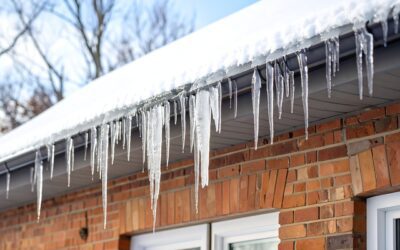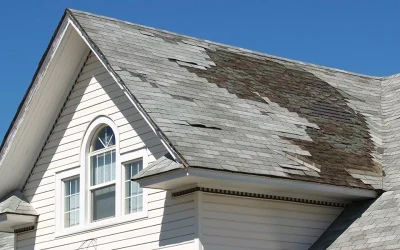30 Roofing Terms You Need to Know
Understanding the jargon and terminology used in the roofing industry will help you communicate effectively with contractors and make informed decisions about your roof. Whether you’re planning a roof repair or replacement or just want to be well-informed, here are 30 roofing terms you need to know:
Roofing Materials
Roofing materials are diverse, offering a range of options to meet specific needs, styles, and climates.
1. Asphalt
Asphalt shingles are one of the most popular roofing materials due to their affordability and durability. They’re made with a base mat of either organic fibers or fiberglass.
2. Metal
Metal roofs, usually available in copper, zinc, aluminum, or steel panels, are known for their long lifespan, lightweight feel, and resistance against adverse weather conditions.
3. Tiles
Tile roofing, usually made from clay or concrete, offers a distinctive look and is commonly found in Mediterranean or Spanish-style homes.
4. Slate
Slate roofs are made from natural stone and offer unparalleled durability and a distinctive, elegant appearance.
5. Wood Shakes
Wood shakes or shingles are traditional roofing materials known for their natural, rustic charm.
Types of Roofs
There are numerous types of roofs, each with its own design, purpose, and aesthetic appeal.
6. Gable
A gable roof is characterized by its triangular shape, which is formed by two sloping surfaces that meet at the top.
7. Hip
A hip roof has slopes on all four sides that come together at the top to form a ridge.
8. Flat
As the name suggests, a flat roof appears almost level to allow for the most efficient use of space.
Roofing Structures
Gaining knowledge about basic roofing structures will help you understand the complexity and scope of roofing projects.
9. Rafters
Rafters are wooden beams that extend from the peak of the roof down to the eaves. They form the skeleton of the roof and provide the structure on which the roofing material is laid.
10. Sheathing
Sheathing, also known as roof decking, is the layer of boards or sheet material that is attached to the rafters and serves as the base for the shingles or other roofing materials.
11. Trusses
Roof trusses are engineered components that support the roof and transfer their weight to the exterior walls. They are typically made from wood or steel.
12. Underlayment
Underlayment is a resilient, waterproof layer installed directly onto the roof deck. It provides an additional barrier against water and wind.
Key Roofing Components
Understanding the key elements of a roofing system will allow you to communicate effectively with roofing professionals.
13. Flashing
Flashing is a thin piece of metal installed to prevent water from leaking in at intersections or projections, like chimneys, vents, and valleys.
14. Eaves
Eaves are the edges of the roof that overhang the face of a wall to keep water from running down the walls.
15. Valley
The valley is the internal angle formed by the intersection of two sloping roof planes.
16. Drip Edge
The drip edge is a metal flashing or strip that extends beyond the eaves and rakes to help control the flow of water away from the fascia and protect the underlying roofing components.
Roofing Installation Terms
Knowing these installation terms will help you understand more about the roofing process.
17. Decking
Decking is the layer of plywood or oriented strand board (OSB) that is installed over the roof rafters or trusses. It provides a solid base for the roofing materials, such as shingles or metal panels.
18. Squaring
In roofing, squaring is a way to ensure that the roof structure is correctly aligned at right angles on all corners before the roof is installed.
19. Nailing
Nailing is the process of securing the roofing materials to the decking. The type of nails that are used depends on the type of roofing material.
Roofing Measurements
Knowing these terms will help you decipher estimates and contracts.
20. Square
In roofing, a “square” is a term used to measure a roof’s size, and it’s equivalent to 100 square feet.
21. Pitch
Pitch refers to the angle or slope of a roof and is typically expressed as a ratio of vertical rise to horizontal spread. For example, a 4/12 roof has a rise of 4 inches for every 12 horizontal feet.
22. Gauge
The gauge is a measure of the thickness of the metal used in metal roofing. The lower the gauge, the thicker the metal.
Roof Weatherproofing and Insulation Terminology
Weatherproofing and insulation terms can help you ensure your roof is protected against the elements and is working efficiently.
23. Ventilation
Ventilation in roofing is the flow of air through the roof system. Ventilation is a crucial component in controlling the amount of heat and moisture in a house.
24. R-Value
The R-value measures the resistance of an insulating material to heat flow. The higher the R-value, the greater the insulation effectiveness.
Roofing Problems and Damage Terminology
Identifying and understanding roofing problems early can save time and money on expensive repairs.
25. Leaking
Leaking in the roofing world refers to the penetration of water into the roof system. This can lead to damage to the interior of the house.
26. Ponding
Ponding, or standing water, is a common problem with flat roofs that occurs when water does not properly drain from the roof.
27. Sagging
Sagging refers to a roof that has dipped in certain areas, usually due to structural issues, like compromised rafters or sheathing.
Roofing Maintenance and Repair Jargon
Knowing the lingo around roofing maintenance and repairs can help you ensure your roof is in good condition.
28. Re-roofing
Re-roofing is the removal of the existing roofing material and the installation of a new one.
29. Overlays
Overlays, or recover, involve the installation of a new layer of shingles over the existing roof.
30. Sealant
A sealant, often made of silicone, acrylic, or polyurethane, is used to fill gaps and seal joints to prevent leaks and water damage.
Bottom Line
Gaining knowledge of roofing terminology boosts your confidence in managing your roof’s upkeep and understanding the work performed by roofing professionals. These terms will come in handy for homeowners, business owners, and people pursuing careers in the roofing industry. Become familiar with each term so you can be in control of your roofing decisions, allowing you to make informed choices and advocate for your best interests. Happy roofing!
If you’re in Plainfield, IN, explore the range of roofing services in Plainfield to find the best solution for your roofing needs.






